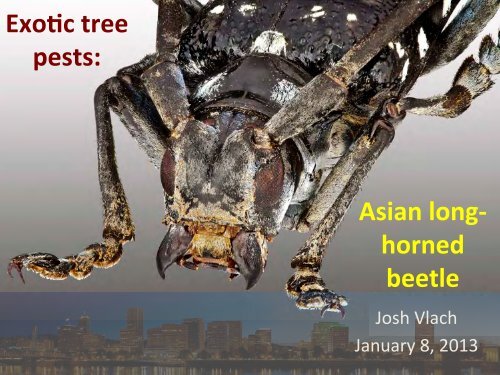Asian Longhorn Beetle
Asian Longhorn Beetle
Asian Longhorn Beetle
You also want an ePaper? Increase the reach of your titles
YUMPU automatically turns print PDFs into web optimized ePapers that Google loves.
Exo3c tree<br />
pests:<br />
<strong>Asian</strong> long-‐<br />
horned<br />
beetle<br />
Josh Vlach<br />
January 8, 2013
Families of importance<br />
• Bark and ambrosia<br />
beetles (Scoly>nae)<br />
• Ambrosia beetles<br />
(Platypodinae)
Families of importance<br />
• Metallic or flat-‐headed<br />
woodborers<br />
(Bupres>dae)<br />
• Horntails (Siricidae)
Families of importance<br />
• <strong>Longhorn</strong>ed or round-‐headed woodborers<br />
(Cerambycidae)
Is this really a problem?<br />
• Other important<br />
woodboring pests<br />
– Mountain pine beetle<br />
(Dendroctonus<br />
ponderosae)<br />
– Dutch elm disease<br />
(Scolytus scolytus, S.<br />
mul4striatus, and now<br />
S. schevyrewi)
Is this really a problem?<br />
– Bronze birch borer<br />
(Agrilus anxious)<br />
hOp://www.missouribotanicalgarden.org/<br />
Portals/0/Gardening/Gardening%20Help/<br />
images/Pests/Bronze_Birch_Borer898.jpg<br />
– Emerald ash borer<br />
(Agrilus planipennis)
Is this really a problem?<br />
– Walnut twig beetle/<br />
thousand cankers<br />
disease (Pityophthorus<br />
juglandis)<br />
– European woodwasp<br />
(Sirex noc4lio)
How do they get here?<br />
• Crate<br />
• Pallet<br />
• Dunnage<br />
• Logs<br />
• Firewood<br />
• Wood cra[s<br />
• Live plant material
What damage can they do?<br />
• Damage cambium
What damage can<br />
they do?<br />
• Phytotoxic mucus
What damage can they do?<br />
• Disease vector<br />
hOp://www.plantmanagementnetwork.org/elements/view.aspx?ID=4593
What damage can they do?<br />
• Mechanical damage
Life cycle<br />
• Summer-‐ oviposi3on
• Larvae hatch<br />
Life cycle<br />
• Larvae take 1-‐2 years to develop
Life cycle<br />
• Overwinter as larvae or pupae<br />
• Adults can emerge May through<br />
November
• Preferred<br />
– Maple<br />
– Birch<br />
– Willow<br />
– Elm<br />
– Horsechestnut<br />
– Buckeye<br />
Hosts<br />
• Possible<br />
– Alder<br />
– Apple<br />
– Ash<br />
– Cherry<br />
– Mountain ash<br />
– Oak<br />
– Pear<br />
– Plane tree<br />
– Plum<br />
– Poplar, CoNonwood<br />
– Russion Olive
<strong>Asian</strong> longhorned beetle<br />
• Originally from China and Korea<br />
• First found in: Brooklyn 1996<br />
– 1998 Chicago<br />
– 2002-‐04 New Jersey (3 loca3ons)<br />
– 2008 Worcestor County,<br />
MassachuseNs<br />
– 2010 Clermont County, Ohio
<strong>Asian</strong> <strong>Longhorn</strong>ed beetle<br />
• Eradicated:<br />
– 2008 Chicago<br />
• Hudson Co., NJ<br />
– 2011 Islip, NY
• Intercepted in 17 states, including California<br />
and Washington
How do we find it early?<br />
• Traps and lures?<br />
• ODA surveys?<br />
• General public?
Iden3fy<br />
the beetle
Oregon fir sawyer<br />
Monochamus scutellatus oregonensis<br />
Na3ve look-‐alikes
Rosalia funebris (Banded alder borer)<br />
Na3ve look-‐alikes
Iden3fy damage:<br />
oviposi3on scar
Iden>fy damage:<br />
emergence holes
Boring dust
ALB Training Simula3on Course
Training is very beneficial<br />
• 2 courses<br />
– 1 st 3me 16% passage<br />
– 2 nd 3me 80% passed
What happens then?<br />
• Mechanical control<br />
• Chemical control
• Imidacloprid<br />
Chemical control<br />
• Trunk and/or soil injec3ons<br />
• Start in March/April<br />
– May treat through July under the right<br />
condi3ons<br />
• Will not save infested trees<br />
• Protects trees from aNack
• Cut<br />
• Chip<br />
• Replant non-‐host<br />
Mechanical control
The Best Op3on<br />
• Don’t let it get here in the first place!<br />
– Only inspect ~2% of imports<br />
– Good SWPM treatment rules<br />
• Interna>onal Plant Protec>on Conven>on-‐ based on<br />
EAB a subcor>cal pest!<br />
• Several incidents of blatant problems<br />
• Must be enforced<br />
– Tighter controls on wood movement in the US<br />
– Especially firewood (but also one of the most difficult to<br />
regulate)<br />
– OR Rule: Firewood restric>ons to prevent<br />
transport of invasive species (ORS 603-‐052-‐1080)
It doesn’t stop here<br />
• The list of new exo3c pests is long. Our<br />
lax efforts will result in establishment of<br />
these pests eventually. Others to look for<br />
in the future:<br />
– Tremex woodwasps<br />
– Redbay ambrosia beetle (Xyleborus<br />
glabratus)<br />
– European woodwasp (Sirex noc5lio)<br />
– And . . .
If you are unsure, give the ODA a call!
Risks we’re unaccustomed to<br />
• Red turpen>ne beetle (Dendroctonus<br />
valens) in China


